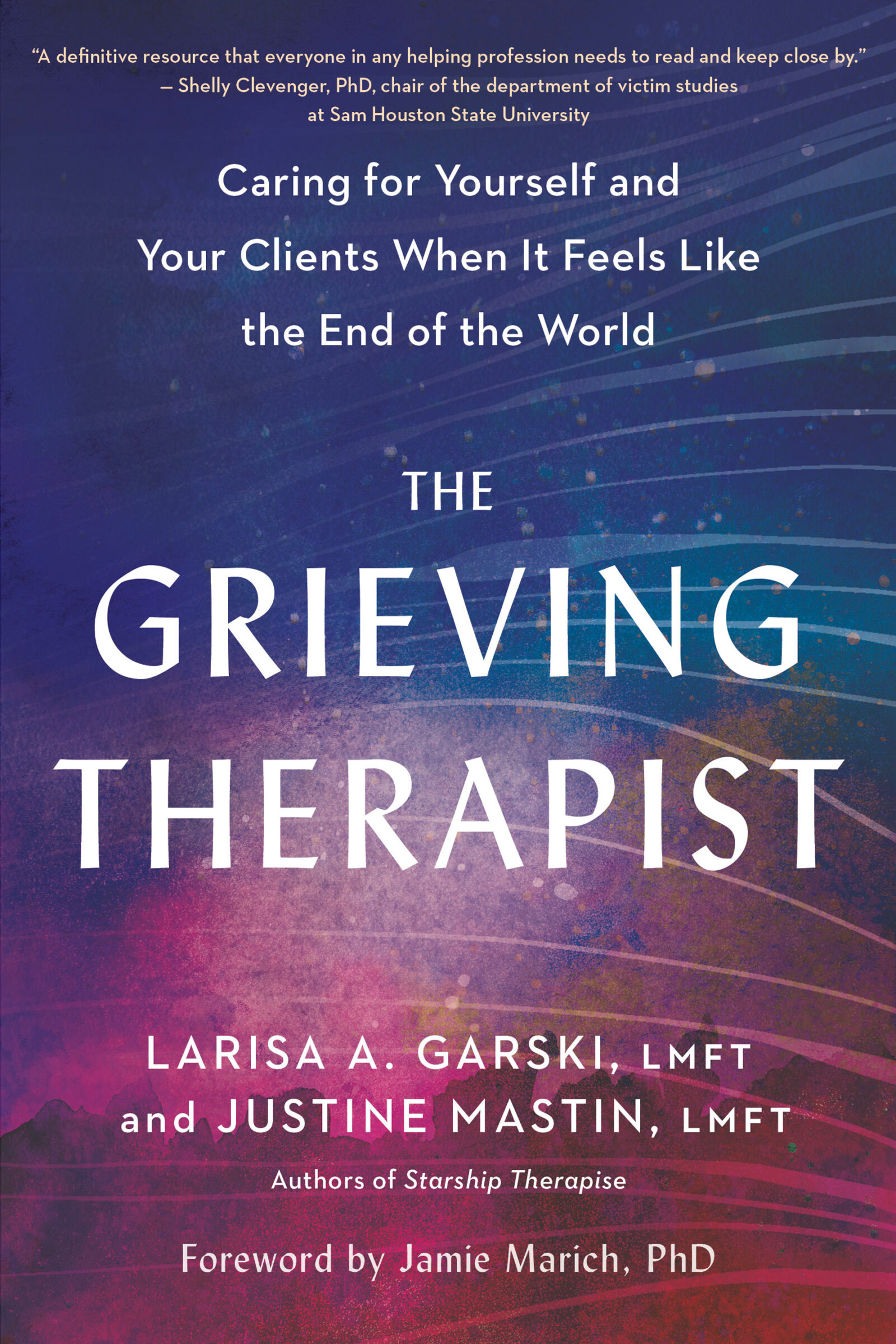
The Grieving Therapist Excerpt
Categories: Excerpt New Release Psychology & Personal Growth
 WE TRIED TO WRITE this introduction so many times. But how do you introduce grief? In a top hat and tap shoes (Justine’s choice)? Perhaps you go retro and quote Emily Dickinson: “After great pain, a formal feeling comes” (Larisa’s choice). You could zoom out to the macro and lean into the longevity of our global grief—rising sea levels, hundreds of thousands dead from a pandemic, ineffectual government—or you could zoom in incredibly close and go micro with a personal anecdote.
WE TRIED TO WRITE this introduction so many times. But how do you introduce grief? In a top hat and tap shoes (Justine’s choice)? Perhaps you go retro and quote Emily Dickinson: “After great pain, a formal feeling comes” (Larisa’s choice). You could zoom out to the macro and lean into the longevity of our global grief—rising sea levels, hundreds of thousands dead from a pandemic, ineffectual government—or you could zoom in incredibly close and go micro with a personal anecdote.
After so many rewrites, we must admit, we found ourselves feeling aggrieved. Ain’t that just the way? Grief is many things; it brings terror and tears and gifts in shitty wrapping paper. It has zero fucks to give about timing. So even though the timing of this introduction finds us personally and professionally bereaved, we’re going to do our best to find some humor in the pain and some joy in the pathos. To paraphrase one of our personal favorites, Carl Jung: you know you’re really alive when you’re feeling all of it—the good, the bad, and the ugly. Therapy, like life, should contain all of it. And since this is a book by therapists for therapists, then this book also needs to contain all of it. Or, to paraphrase a client, it needs to be properly life-y.
The truth is that there is no right way to start because this isn’t the beginning of a story; it’s the middle. We are all still living inside the trauma, not reflecting upon it from some future place. So, reader, we join you in the middle of our grief, which we will lay out for you like a map. This feels appropriate, as maps themselves have no beginning and end; they simply are, and there are a multitude of routes to take across them. There are indeed many roads to the summit.
But before we dive into the life of this book, we need to check our mapmaking supplies and review our provisions. To put this in purely scholastic terms, we’re going to offer a note on theoretical orientation, a summary of structure, and a perspective on self-disclosure, and we’ll conclude with a word on methodology. This journey into grief will take us into uncharted territory for which there are yet no complete maps. But together, reader, we hope to draft a guidebook.
We encourage you to meet this book where you are and to start, stop, reroute, and proceed as needed, but perhaps always with caution. No doubt the road is perilous. But you do not grieve alone. We, your authors and colleagues, walk alongside you.
Our journey begins in the Realm of Our Plague—a place of germs and despair. Your surroundings at first seem like a desolate wilderness, and you are a weary traveler beset on all sides by tribulations, with nary a friend or companion in sight. But just as it begins to feel as if all hope is lost, you peer through the trees—such a dark shade of green that they almost appear black—and make out a dim spark of orange. With cautious optimism, you walk toward this flash of orange, and with each step the spark grows brighter. After a while, your ears prick at the sound of laughter and human voices. How long has it been since you’ve gathered with others in community?
“Oh look, another arrival!” calls a voice from up ahead. You step into a clearing with a blazing campfire in the center, surrounded by many inviting faces. As you stand awestruck and overwhelmed, a tall, bearded fellow hands you a steaming mug, while another member of the community makes room around the fire. “Welcome to therapist base camp,” your new friend says as you sit down and begin the introductions.
This is the therapy community. They, and you, have already been through a terribly tricky trek, and now you are finally joined together to share in the journey to come. Take a moment and consider what you want to share with this community about your solo sojourn to base camp. What were the years of pandemic like for you, both as a person and as a therapist?
Terrors of Telehealth
For us, the authors, the pandemic years were painful. Our solo sojourns were mapless, as are all first adventures. And there were no guides to give us even their own hand-drawn maps. We were all truly explorers, and none of us by choice. We started charting our course across the sea of teletherapy unguided. While there may be those rare therapist birds out there who were practicing in a predominantly virtual manner prior to the COVID-19 pandemic, for most therapists this was a brand-new experience. Offices were suddenly left with many an abandoned house plant to watch as dust gathered on once frequented, but now deserted, desks and silent sofas. Piles of magazines accumulated outside doors, and space-rental bills caused silent weeping.
We found ourselves in the unenviable position of having to explain concepts like social distancing and airborne transmission before we fully understood them ourselves. Our clients turned to us for knowledge and reassurance that we simply did not have. All of us, regardless of therapeutic modality, were thrown into a situation where our clients suddenly knew more about our struggles than we ever thought possible, simply because we were all going through the same global pandemic together.
And we were doing it in the leaky boat of telehealth. Justine hated this new reality. She did not adapt well to the new way of working. Her home was not set up for it, and she had a beautiful office space—for which she was still paying rent—sitting empty. When clients asked Justine how she was doing, she would answer: “We’re in a pandemic!” And clients would nod knowingly. It was a fool’s errand to pretend that any of this was okay. Justine found that clients appreciated her disclosure that she wished she was in the office getting a LaCroix from the mini-fridge, rather than passing her partner in her own kitchen during breaks. The irony is that although Justine initially hated working from home, she has now made the hard decision to give up her space and will likely never return to a brick-and-mortar facility for clinical practice. It took the better part of the first year of the pandemic for her to adapt, but once she created a cozy space to work in her home, she found that working remotely suits her multiproject-filled lifestyle.
This was not everyone’s experience. Many therapists found themselves struggling to make the impossible work, learning that virtual play therapy was as oxymoronic as it sounded. While on one of her ubiquitous COVID walks, Justine ran into a social worker neighbor who described doing virtual sandtray therapy with children as “the most boring video game ever.” Many more found themselves pressured by practice owners or community mental health administrators to return to the office sooner than felt safe, while others pushed to return to “normal” as soon as possible. For those first six months of 2020, everything just felt wrong. Notice what comes up for you when you think back to those initial weeks and months. Can you remember when the message was that the lockdown would be for two weeks, and then four, and then six? And how you felt when it moved to an indefinite length of time?
At the time of this writing, we find ourselves two and a half years into the COVID-19 outbreak. Many therapists have become more practiced at virtual therapy, but that doesn’t mean teletherapy is equivalent to in-person therapy. Adaptation is not always synonymous with functionality. We are all experienced at coping, and we do it well. And yet, we remember what it was like before. If you are a new clinician or a student who does not have this memory, your body still knows that this is not quite right. Your body probably alerts you to this fact in a variety of ways, and we’ll talk more about this in the section on education.




